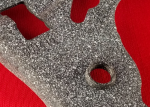- Joined
- Aug 25, 2017
- Messages
- 6
- Points
- 0
Hi everyone, excited to have found this group and hoping that someone can point me in the right direction. I have an application where I am taking multiple images of an object from different angles so that I can use standard computer vision techniques to reconstruct the 3D shape of the object. The reconstruction relies on surface texture, which becomes a problem if we have shiny surfaces. The workaround is to spray such surfaces with a fine powder, e.g. talc spray or paint, so that some artificial texture is created. See the attached images for an example of a shiny metallic surface with a fine speckling made by spraying black and white paints. While this works, it introduces additional processing steps to create and remove the texture and often this is a huge problem.
As an alternative, I was wondering if we could project a random texture on to the part, similar to the one in the figure, using some sort of a projector. Colour is not relevant, but the projected pattern needs to be in the visible range since I cannot use IR cameras. The pattern can be of any colour and it is also okay if the native surface is seen between the projected dots. I am mainly interested in cutting down the specular reflection and obtaining a random texture optically. Pico projectors will probably work, but they are not small enough or cheap enough for our application. Instead, I was wondering if we could modify low-cost laser pointers that throw patterns on the screen. Can these be tweaked to throw random user-defined patterns instead of the systematic patterns they usually project? Plus, their intensity also drops from the center to the edge, can this be avoided? Or, if there are other inexpensive ways of doing this, I would be very grateful to hear about them.
Thanks.
Shankar
As an alternative, I was wondering if we could project a random texture on to the part, similar to the one in the figure, using some sort of a projector. Colour is not relevant, but the projected pattern needs to be in the visible range since I cannot use IR cameras. The pattern can be of any colour and it is also okay if the native surface is seen between the projected dots. I am mainly interested in cutting down the specular reflection and obtaining a random texture optically. Pico projectors will probably work, but they are not small enough or cheap enough for our application. Instead, I was wondering if we could modify low-cost laser pointers that throw patterns on the screen. Can these be tweaked to throw random user-defined patterns instead of the systematic patterns they usually project? Plus, their intensity also drops from the center to the edge, can this be avoided? Or, if there are other inexpensive ways of doing this, I would be very grateful to hear about them.
Thanks.
Shankar




